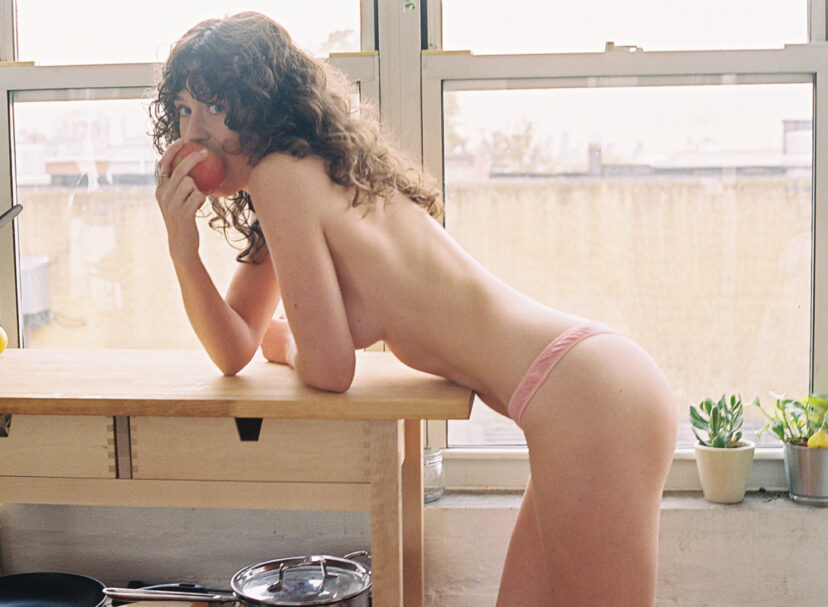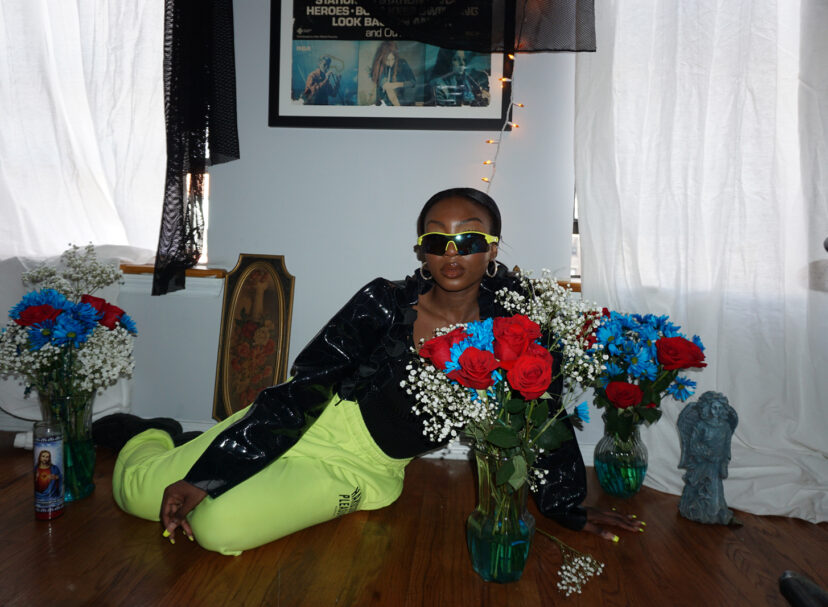Text: Monica Uszerowicz
Photos: Olimpia Dior

The preview video for “The Displaced,” the newest collection by designer JAHNKOY, feels like a trailer for a film: young men from around the globe, decked out in JAHNKOY’s characteristically ostentatious colors and gems—as if the men themselves are jewels—take to the streets of New York City, posing and moving throughout like a playground. Russian designer Maria Jahnkoy’s label seeks to place emphasis on both cultural heritage and thoughtful sustainability—in essence, the preservation of people and materials.
Her reworked items (jerseys, sportswear, secondhand clothing, objects found in bodegas) are transformed into brilliant, bright, conscious textiles, with patches proclaiming “Don’t Bring Shit to Africa” and “WAH YA DEFEND”—a good question, really, for anyone with a platform big enough to create awareness about the problematics of consumption and the way the fashion world is emblematic of the rest of it. Why not, then, spread a message about the empowerment of the oppressed, and the importance of socially conscious fashion? JAHNKOY attempts to take what’s typically used as “inspo” and “tribal wear” by culturally appropriative designers and gives it back its own space, utilizing craftsmanship, all the while addressing the dangers of the “fast-fashion” industry and its threat as an environmental pollutant.
The Displaced Newspaper—an accompanying booklet about the project—is filled with images and quotes referencing the importance of revolution (and revolutionary ideas), and contains a text that proposes the idea of craft as ancestral healing: “Understanding how something is made, why it is made that way, and by whom it is made is more vital to modern life than ever,” it reads. “Craft is a constant conversation between material, origin and creation…It reconnects people to their ancestors history. It promotes the use of various cross-disciplinary media, the opportunity for individuals to participate in projects that value democratic processes, and an ongoing commitment to politicized practices, issues, and actions. Craftsmanship is the constructive and non-violent instrument for opposing the dominant model of production.”
We spoke to Maria over e-mail about these ideas, the meaning of JAHNKOY, and the line’s collaboration with brands like Puma, Swarovski, and Samsung.


The Displaced...is about the rapid growth of the fast fashion industry, that creates tons of poisonous material which is being dumped into so called ‘third world’ countries, destroying the ecosystem while simultaneously destroying the development of textile and craft industry, and as a result—culture.


You’ve told this story before, but when did you decide to follow your heart, leave economics, and work in fashion?
I have always followed my heart; it is just getting stronger with age. I left Novosibirsk State University at 19. After coming back from a summer program in San Francisco where I worked for three months in various service jobs and felt what the outside world looks like, I came back and realized that I only live once and it’s time for a change.
JAHNKOY means New Spirit Village in Crimean Tatar Language, correct? What inspired this name?
Yes, that’s right. When I was a teenager, I was on 3.5-day train trip from Novosibirsk to Crimea. Somewhere in the middle I heard Джанкой [Dzghankoy]. It was the name of the station and a small town. I loved the sound so much; it just resonated with me. Based on my upbringing, I spelled it JAHNKOY. When I came back home and told my family that it’s my new name, my grandfather was really upset. He found in the encyclopedia the meaning and the origin; he thought I would change my mind when I found out it means “village.” Now it makes more sense.
Looking at The Displaced, along with the pieces you showed with the UNITE collective several years ago, it’s obvious that you are thinking about the empowerment of displaced peoples and displaced histories. Can you tell me about the project, along with the name Displaced?
The Unite show was in September 2016. Pieces that I showed at the Unite show were from a body of work that I‘ve created throughout my life; it was a collection of various projects from six years of schoolwork in Moscow, London, and NYC. All of the pieces had different origins and meanings. All were created out of love and stood for the same purpose: To unite and empower individuals.
The year after, I graduated from Parsons’ Masters of Fine Art “Fashion Design and Society” program. The project I created is called “The Displaced.” It speaks about the displacement and disappearance of a variety of cultures throughout the world. It’s about people’s ways of dress that became “costume,’ and only used in fashion as an inspiration, while actual knowledge of craft and tradition is disappearing. It is about the rapid growth of the fast fashion industry, that creates tons of poisonous material which is being dumped into so called “third world” countries, destroying the ecosystem while simultaneously destroying the development of textile and craft industry, and as a result—culture.
It is about the reality of our everyday life. We are all in this together and it’s time to do something about it.

You’ve said fashion can be a tool for social change. Why is fashion important, and how are you using this platform? What histories are you helping to create?
We are not in a history yet; we are in a present moment and we are trying our best to make it more suitable to ourselves. The outward environment should reflect the inner state of being. So whatever one creates and adds to the outside world is what he has inside of him. Fashion is a reflection of social reality. Fashion is very important; it is almost critical in social construct. It is the system that dictates what is valuable and what is being erased. It sets the ‘accepted norm.’ So we have to push the boundaries, breathe a little bit.
Tell me about the construction of the garments, physically and technically speaking. I noticed you incorporate nationalist imagery and flags. Do you recycle and work with sustainable materials?
I design directly on the person, using ready-made garments. I recut and reshape them into new silhouettes based on the memory of the past and the imagination of the present. The person and the material dictate the movement and the direction. I work with standardized sportswear garments and the cheap products that are sold in bodega stores, as well as found objects and recycled materials. I rework and embellish them until my eye is satisfied. Most of the garments are adorned with Swarovski crystals, intricate beadwork, and embroidery. I basically create a collage that speaks to me; it carries the message and the story.
I used the flags that I bought in my neighborhood, to reflect the origins of it and the place of actual production. I collaged them in one cape to celebrate the community I live in and to remove the borders that flags represent: to unite us all under one aim of consciousness.
How did you get involved with PUMA, Samsung, and Swarovski for The Displaced?
It was very organic. Kering and Swarovski support Parsons’ MFA Program, and it was a part of our curriculum to design for both companies. As part of Kering’s school project, I was fortunate to draft PUMA to reimagine the brand in the role of creative director. We had to create a proposal for new design practices. My fashion collection is the result of it. Both PUMA and Swarovski are deeply engaged with achieving the most sustainable practices in their production, and therefore were interested and supportive of my project.
For the Council of Fashion Designers and South Africa Fashion Week shows, I added the name Crafting Revolution and created new looks, for which I recut PUMA apparel and customized Ignite shoes. It is a proposal on how we can weave advanced modern technology, city wear, and traditional craftsmanship to create a product that will be modern and that still develops and fosters hand skills and artisanal tradition. Learning from the past, we aim to create a better future.
Samsung is a sponsor of CFDA and they support all emerging designers with technological innovation to be integrated within design practices.
How did you meet the men who model your Displaced collection, and how are they part of it—beyond just modeling?
I meet people on daily basis, mostly on the street or in the subway. It is a magical moment, which I cherish. A lot. It’s when you know that you both know, and then you greet each other. Those moments co-create your journey and educate you along the way. Most of the guys I met, I met exactly like that, and later we shared a lot of great moments together, while beading, reasoning, or dancing. They support me greatly and don’t allow me to ever give up. They keep reminding me that we have to move up and forward.



